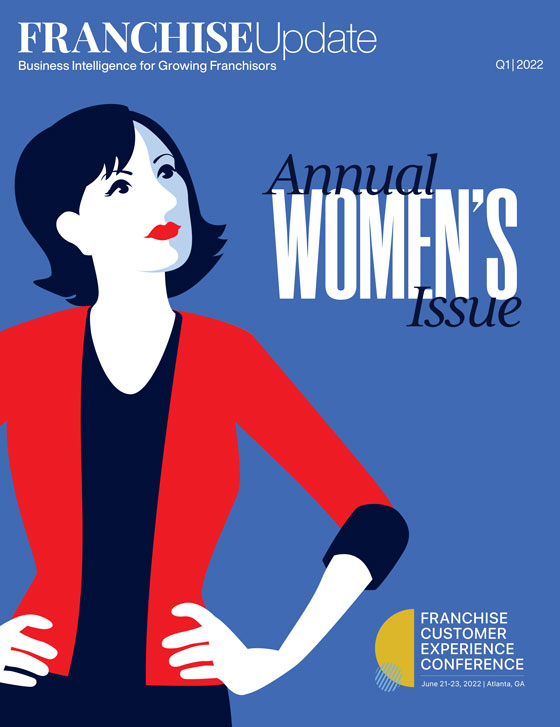How Covid Is Changing Franchisors' Offering Models in 2022

Some of our recent research for franchisors is helping us understand how changes in behavior resulting from the pandemic are translating into the altered execution of the franchise business model. We all have an inner desire to have things to return to the way they were because we understood them. Now we realize some changes aren’t going away, even though they were crisis-driven. Consumers become accustomed to change the longer they live with it. When you see behavior changing, you must evaluate your model, because it likely needs adjusting.
I’ve written before about some of the consumer behavior changes franchisors are recognizing as significant as they look at their offering models. A good example is how quickly we embraced online calls with our medical care providers. We found the convenience and time-saving benefits of a significant range of medical appointments online that just a couple years ago we infrequently (if at all) were willing to consider – despite the technology being offered, even encouraged, by the medical profession. This compressed timeline for adoption is important to keep in mind as we evaluate how the pandemic has altered the consumer journey.
This article focuses on some of the many functional responsibilities of the franchisor. Franchisors are now asking us to help them better understand how consumer behavior trends might inform a better approach to franchisee interaction. While connecting changing consumer behavior to modifications in franchisor services is influenced by each specific industry, the complexity of the offering, along with other factors, some general conclusions can be drawn.
Franchisee training programs sit in the middle, between development and eventual outcomes. To a significant extent, the type of prospects the development function brings in and the system performance outcomes that result are influenced by the effectiveness of the training program. The past 2 years have forced training programs online.
Clients have asked us what they should prepare for when the pandemic is in the rearview mirror. They were focusing mostly on the question of online versus in-person. As we looked into it, we found that wasn’t the only question – and often not even the most important one. I’ll share some general observations here.
Aligning with today’s candidates
Most training program content has not changed much over the past few years, except in relation to joint employer considerations. The pandemic did change the way training programs were being delivered, but that’s about it. Yet, have you considered how the type of prospects coming in and their expectations have changed?
Our research work in this area often starts with a client’s prospect screening and skills evaluation. We have found that training modules often were slow to adjust, if they did at all, to how prospects look today. We have two new generations of candidates in Millennials and Gen Zers. Is there alignment between prospect skills and training programs? We’ve learned a lot about these new generations from our franchisor interactions. One thing we’ve found is that this alignment is essential before the method of training delivery is considered.
We then found it is important to look at the outcome of current training: How quickly do franchisees hit their stride, and how do they do over time? Our work in this area has shown that training often has not adapted, and operations must step in to pick up any training gaps. When training is evaluated with this type of data analysis, content can be adjusted. Aligning prospect screening and training might mean, for example, changing screening instead of training to emphasize certain skills that training is not addressing or not addressing well.
Turning to the means of training delivery, we know that most franchisors put great value in face-to-face interaction and want to return to that model as soon as possible. However, the pandemic might be changing what prospects want. The question is how effective the interim has been for franchisors. In other words, is a preference for face-to-face necessary to get the same outcomes? Our research is finding that the answer is not as simple as pick one or the other, but often a blend of the two.
Understanding what the franchisee wants, as well as needs, will guide franchisors toward an answer to online versus in-person. One of the higher values of good research is separating biases from reality. We frequently find that what a client or a research target wants is not what they need.
The example I’ve used in this article, of clients asking for best practices of online versus in-person training, isn’t always what is needed. The former can lead down a technology path that seems like good solution, but it can easily end up unused or not solving the issue… because it was not addressing the right question.
Darrell Johnson is CEO of FRANdata, an independent research company supplying information and analysis for the franchising sector since 1989. He can be reached at 703-740-4700 or djohnson@frandata.com.
Share this Feature
Recommended Reading:
Comments:
comments powered by DisqusFRANCHISE TOPICS
- Multi-Unit Franchising
- Get Started in Franchising
- Growth
- Operations
- Open New Units
- Leadership
- Marketing
- Technology
- Legal
- Awards
- Rankings
- Trends
- Featured Franchise Stories
FEATURED IN

Franchise Update Magazine: Issue 1, 2022






 The franchise listed above are not related to or endorsed by Franchise Update or Franchise Update Media Group. We are not engaged in, supporting, or endorsing any specific franchise, business opportunity, company or individual. No statement in this site is to be construed as a recommendation. We encourage prospective franchise buyers to perform extensive due diligence when considering a franchise opportunity.
The franchise listed above are not related to or endorsed by Franchise Update or Franchise Update Media Group. We are not engaged in, supporting, or endorsing any specific franchise, business opportunity, company or individual. No statement in this site is to be construed as a recommendation. We encourage prospective franchise buyers to perform extensive due diligence when considering a franchise opportunity.